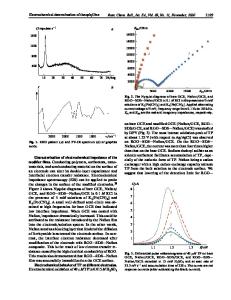A label-free biosensor based on graphene and reduced graphene oxide dual-layer for electrochemical determination of beta
- PDF / 663,539 Bytes
- 10 Pages / 595.276 x 790.866 pts Page_size
- 56 Downloads / 373 Views
ORIGINAL PAPER
A label-free biosensor based on graphene and reduced graphene oxide dual-layer for electrochemical determination of beta-amyloid biomarkers Jagriti Sethi 1
&
Michiel Van Bulck 2,3 & Ahmed Suhail 1 & Mina Safarzadeh 1 & Ana Perez-Castillo 2,3 & Genhua Pan 1
Received: 2 November 2019 / Accepted: 10 April 2020 # The Author(s) 2020
Abstract A label-free biosensor is developed for the determination of plasma-based Aβ1–42 biomarker in Alzheimer’s disease (AD). The platform is based on highly conductive dual-layer of graphene and electrochemically reduced graphene oxide (rGO). The modification of dual-layer with 1-pyrenebutyric acid N-hydroxysuccinimide ester (Pyr-NHS) is achieved to facilitate immobilization of H31L21 antibody. The effect of these modifications were studied with morphological, spectral and electrochemical techniques. The response of the biosensor was evaluated using differential pulse voltammetry (DPV). The data was acquired at a working potential of ~ 180 mVand a scan rate of 50 mV s−1. A low limit of detection (LOD) of 2.398 pM is achieved over a wide linear range from 11 pM to 55 nM. The biosensor exhibits excellent specificity over Aβ1–40 and ApoE ε4 interfering species. Thus, it provides a viable tool for electrochemical determination of Aβ1–42. Spiked human and mice plasmas were used for the successful validation of the sensing platform in bio-fluidic samples. The results obtained from mice plasma analysis concurred with the immunohistochemistry (IHC) and magnetic resonance imaging (MRI) data obtained from brain analysis. Keywords Graphene . Aβ1–42 detection . Alzheimer’s disease . Electrochemical biosensors . Screen-printed electrodes
Introduction The current trend in the realm of medical science is to investigate the molecular basis of ailments as opposed to following a symptomatic approach. This has prompted remarkable improvements in research for chronic ailments such as Alzheimer’s disease (AD). Abnormal levels of certain biomarkers in bio-fluids have been associated with AD Electronic supplementary material The online version of this article (https://doi.org/10.1007/s00604-020-04267-x) contains supplementary material, which is available to authorized users. * Jagriti Sethi [email protected] 1
Wolfson Nanomagnetics Laboratory, School of Engineering, Computing and Mathematics, University of Plymouth, Devon PL4 8AA, UK
2
Instituto de Investigaciones Biomédicas (CSIC-UAM), Arturo Duperier, 4, 28029 Madrid, Spain
3
Centro de Investigación Biomédica en Red sobre Enfermedades Neurodegenerativas (CIBERNED), Valderrebollo, 5, 28031 Madrid, Spain
progression [1]. One such biomarker is beta-amyloid (Aβ) peptide consisting of 40 and 42 amino acids, namely Aβ1–40 and Aβ1–42. Their abnormal levels in bio-fluids have been correlated with amyloid pathology in AD-affected brain [2]. The continuous monitoring of Aβ levels could provide aid in early diagnosis, before the onset of symptoms [3]. As a result, several platforms including enzyme-linked immunosorbent assay (ELISA
Data Loading...











